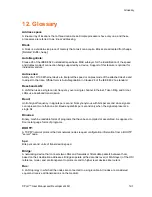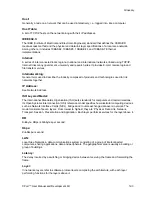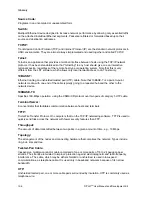
Glossary
Byte:
A data unit of eight bits.
Channel:
The data path between two nodes.
Domain Name:
A domain name is a text name appended to a host name to form a unique host name across
internets.
Download:
The transfer of a file or information from one network node to another. Generally refers to transferring
a file from a "big" node, such as a computer, to a "small" node, such as a terminal server or printer.
File Transfer Protocol, a TCP/IP protocol for file transfer.
End Node:
A node such as a PC that can only send and receive information for its own use. It cannot route and
forward information to another node.
Ethernet:
The most popular LAN technology in use today. The IEEE standard 802.3 defines the rules for
configuring an Ethernet network. It is a 10 Mbps, CSMA/CD baseband network that runs over thin
coax, thick coax, twisted pair or fiber optic cable.
Firmware:
Alterable programs in semipermanent storage, e.g., some type of read-only or flash reprogrammable
memory.
Flash ROM:
See ROM.
Framing:
Dividing data for transmission into groups of bits, and adding a header and a check sequence to form
a frame.
FTP:
Full-Duplex:
Independent, simultaneous two-way transmission in both directions, as opposed to half-duplex
transmission
Gateway:
A device for interconnecting two or more dissimilar networks. It can translate all protocol levels from
the Physical layer up through the Applications layer of the OSI model, and can therefore interconnect
entities that differ in all details.
Hardware Address:
See Network Address.
12-2
XPort™
User Manual and Development Kit






































